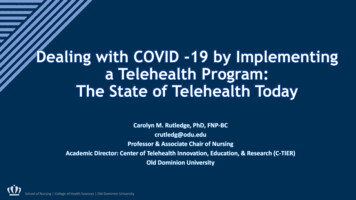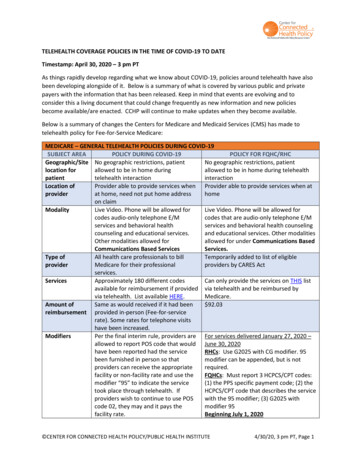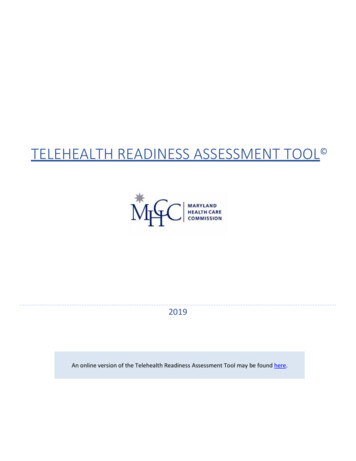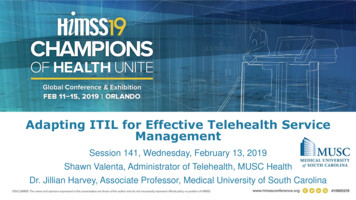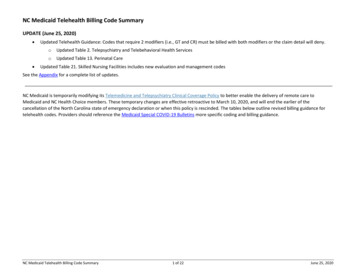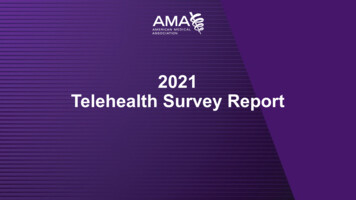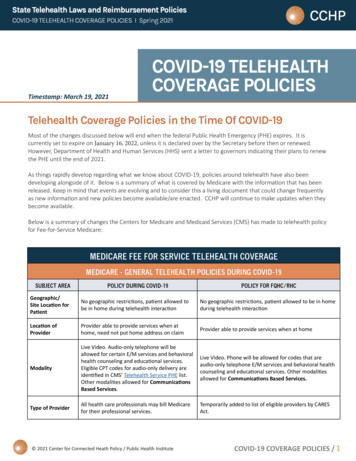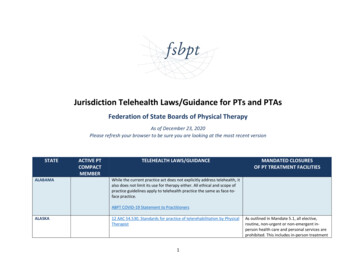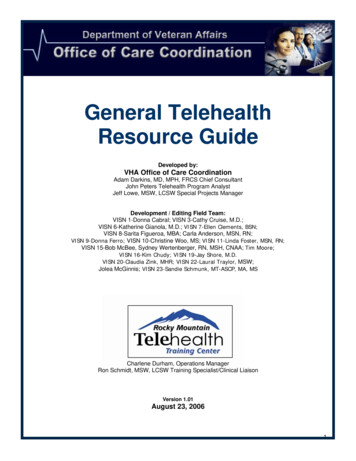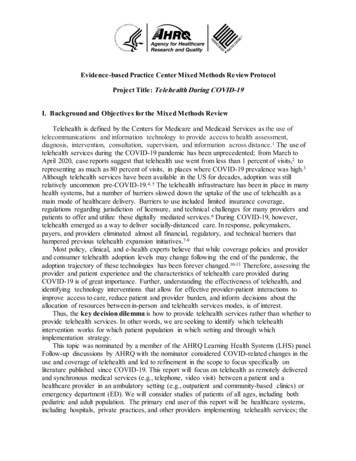
Transcription
Evidence-based Practice Center Mixed Methods Review ProtocolProject Title: Telehealth During COVID-19I. Background and Objectives for the Mixed Methods ReviewTelehealth is defined by the Centers for Medicare and Medicaid Services as the use oftelecommunications and information technology to provide access to health assessment,diagnosis, intervention, consultation, supervision, and information across distance.1 The use oftelehealth services during the COVID-19 pandemic has been unprecedented; from March toApril 2020, case reports suggest that telehealth use went from less than 1 percent of visits,2 torepresenting as much as 80 percent of visits, in places where COVID-19 prevalence was high.3Although telehealth services have been available in the US for decades, adoption was stillrelatively uncommon pre-COVID-19.4, 5 The telehealth infrastructure has been in place in manyhealth systems, but a number of barriers slowed down the uptake of the use of telehealth as amain mode of healthcare delivery. Barriers to use included limited insurance coverage,regulations regarding jurisdiction of licensure, and technical challenges for many providers andpatients to offer and utilize these digitally mediated services.6 During COVID-19, however,telehealth emerged as a way to deliver socially-distanced care. In response, policymakers,payers, and providers eliminated almost all financial, regulatory, and technical barriers thathampered previous telehealth expansion initiatives.7-9Most policy, clinical, and e-health experts believe that while coverage policies and providerand consumer telehealth adoption levels may change following the end of the pandemic, theadoption trajectory of these technologies has been forever changed.10-13 Therefore, assessing theprovider and patient experience and the characteristics of telehealth care provided duringCOVID-19 is of great importance. Further, understanding the effectiveness of telehealth, andidentifying technology interventions that allow for effective provider-patient interactions toimprove access to care, reduce patient and provider burden, and inform decisions about theallocation of resources between in-person and telehealth services modes, is of interest.Thus, the key decision dilemma is how to provide telehealth services rather than whether toprovide telehealth services. In other words, we are seeking to identify which telehealthintervention works for which patient population in which setting and through whichimplementation strategy.This topic was nominated by a member of the AHRQ Learning Health Systems (LHS) panel.Follow-up discussions by AHRQ with the nominator considered COVID-related changes in theuse and coverage of telehealth and led to refinement in the scope to focus specifically onliterature published since COVID-19. This report will focus on telehealth as remotely deliveredand synchronous medical services (e.g., telephone, video visit) between a patient and ahealthcare provider in an ambulatory setting (e.g., outpatient and community-based clinics) oremergency department (ED). We will consider studies of patients of all ages, including bothpediatric and adult population. The primary end user of this report will be healthcare systems,including hospitals, private practices, and other providers implementing telehealth services; the
report will also be of interest to payers reimbursing providers for telehealth services, and patientsengaging in or considering use of telehealth services.The decision dilemma can be addressed by both quantitative and qualitative research designs,thus we are conducting a mixed-methods or integrative review.14 The state of evidence – havinga variety of both quantitative and qualitative studies – also dictates that such an approach wouldbe most useful and informative at this time. We will integrate quantitative evidence (using asystematic review) and qualitative evidence synthesis through a convergent segregated approach,where syntheses are conducted independently and simultaneously, and the quantitative andqualitative evidence is then integrated to provide a comprehensive picture of available evidenceon telehealth throughout the pandemic.II. Contextual and Key QuestionsKey Questions were made available for comment between June 17, 2021 and July 8, 2021.Sixteen sets of comments were received. The JHU EPC identified two common themes thatwould expand the scope of the review: (1) include literature prior to the era of COVID-19, and(2) include other types of virtual health beyond synchronous telehealth, such as wearable devicesand apps. Each of these considerations had been discussed with the Stakeholders during the topicrefinement phase; neither change was considered critical for this review. The LHS panelrepresentative concurred with this decision.The following are the Key Questions (KQ) to be addressed in the mixed methods review:KQ 1. What are the characteristics of patient, provider, and health systems using telehealthduring the COVID-19 era, specifically:a. What are the characteristics of patients (e.g., age, race/ethnicity, gender, socioeconomicstatus, education, geographic location (urban versus rural))?b. What are the provider and health system characteristics (e.g., specialty, geographiclocation, private practice, hospital-based practice)?c. How do the characteristics of patients, providers, and health systems differ between thefirst four months of the COVID-19 era versus the remainder of the COVID-19 era?KQ 2. What are the benefits and harms of telehealth during the COVID-19 era?a. Does this vary by type of telehealth intervention (i.e., telephone, video visits)?b. Does this vary by patient characteristic (i.e., age, gender, race/ethnicity, type of clinicalcondition or health concern, geographic location)?c. Does this vary by provider and health system characteristic (e.g., specialty, geographiclocation, private practice, hospital-based practice)?KQ 3. What is considered a successful telehealth intervention during the COVID-19 era:a. From the patient or caregiver perspective?b. From the provider perspective?c. From the health system perspective?KQ 4. What strategies have been used to implement telehealth interventions during the COVID19 era?a. What are the barriers and enablers of a successful telehealth strategy (e.g., setting,reimbursement, access to technology)?o From the patient or caregiver perspective?2
o From the provider perspective?o From the health system perspective?We are addressing two Contextual Questions (CQ) about implementation as well as policyand reimbursement of telehealth.CQ 1. What are the costs of implementation and return on investment for telehealth during theCOVID-19 era to the provider/healthcare system?CQ 2. What are the policy and reimbursement considerations for telehealth during the COVID19 era?a. How are these policy and reimbursement considerations for telehealth changing in thepost-COVID-19 era (from March 2020, when the World Health Organization declaredCOVID-19 a pandemic to present); at the federal level (policies such as Medicare), statelevel (policies such as Medicaid), and by private insurance payers?b. How do changes in reimbursement policies impact telehealth strategies?III. Analytic FrameworkAnalytic framework for Telehealth During COVID-19.ED emergency department; IDS integrated delivery system; IP inpatient; KQ Key Question; LHS learning healthsystem; OP outpatientIV. MethodsA. Criteria for Inclusion/Exclusion of Studies in the ReviewThe criteria for inclusion and exclusion of studies for the mixed methods review will bebased on the Key Questions and are described using the PICOTS framework in Table 1(Population, Intervention, Comparison, Outcome, Timing, Setting).3
Table 1. PICOTS: Inclusion and exclusion criteriaPICOTInclusionExclusionPopulationAll KQ: Patients of any age(or their caregivers for KQ3KQ4) Health systems Hospitals ProvidersAll KQ:Patients receiving inpatient care.Providers providing inpatient careInterventionsKQ 1-3: Remotely delivered synchronous medicalservices (e.g., telephone, video visits) betw een apatient and a healthcare provider in anambulatory setting (e.g., outpatient andcommunity-based clinics) or ED providingo acute/urgent care (e.g., symptommanagement); routine/chronic care (e.g.,preventive services, chronic diseasemanagement); mental health services;w ellness visits; post-hospital discharge care(e.g., routine follow -up and care for nonacuteissues) Patient and specialist communications facilitatedby an ED physician in an ED (particularlyimportant in rural care setting)All KQ:Remotely delivered, non-synchronousmedical services (e.g., remotemonitoring devices, health apps,w earable devices, patient portals)KQ4: Implementation strategies for telehealthCom paratorsKQ 1-3: In-person care, no care, no comparisonKQ 4: Implementation strategies for telehealthNAOutcom esKQ 1: Not applicableKQs 2 and 3:o Patient/provider-level outcomes Patient satisfaction/perceptions Physician /providersatisfaction/engagement/burnouto System outcomes Healthcare access (e.g., insurancecoverage, WIFI and smartphone access) Healthcare utilization (e.g., hospitalization,readmission, ED visit) Healthcare performance and qualitymeasures (e.g., adhering or meetingHealthcare Effectiveness Data andInformation Set (HEDIS) standards or othervalidated quality measures), e.g.: Practice efficiency No-show rates Staffing hours Cycle times Communicationo Clinical outcomes(any) Medication adherence Up to date lab valueso Adverse effects/patient safety issues Inappropriate treatment Misdiagnosis/delayed diagnosis/care Case resolution/Duplication of services(telehealth follow ed immediately by in-personvisit) Privacy/confidentiality breachesNA4
Cost (see Appendix A for detailed costoutcomes)KQ4:o Barriers and enablersoTim ingSettingStudy Design†All KQ: the era of COVID-19 (March 2020-present)KQ1d: During the first 4 months or beyond the initialphase.*Studies completed prior to the era ofCOVID-19ALL KQ:o Healthcare provided outside of a medical officevia phone or video.Inpatient settingoHealthcare provided in an ED by a specialist viaphone or video.oU.S.-like outpatient population (including ED) (seeAppendix B for a list of included countries)Non-U.S. based studies w ith differentpatient population or health systemcharacteristics.KQ1: claims and EHR dataKQ 2 and 4o Qualitative studies: focus groups, interview so Quantitative studies: RCT, CT, observationalstudies, and surveysKQ3: Qualitative studies: focus groups, interview s* Studies that began before the era of COVID-19 (11 March 2020) and extend into the era of COVID-19 will beexcluded unless they meet the following criteria: data from the pre and post COVID-19 era are stratified—thestratified data will be extracted; studies initiated as early as 1 January 2020 can be included if they are studies oftelehealth in response to COVID-19.To be eligible for inclusion as a qualitative study, the Sampling, data collection, and data analyses must besystematically conducted; data must be analyzed using methods of qualitative data analysis (such as thematicanalysis).†CT controlled trial; ED emergency department; EHR electronic health record; HEDIS HealthcareEffectiveness Data and Information Set; KQ key question(s); NA not applicable, RCT randomized controlledtrial5
Table 2. Proposed methods by key question.Key Question1. What are the characteristicsof patient, provider and healthsystems using telehealth duringthe COVID-19 era, specifically2. What are the benefits andharms of telehealth during theCOVID-19 era?3. What is considered asuccessful telehealthintervention during the COVID19 era?4. What strategies have beenused to implement telehealthinterventions during the COVID19 era?Proposed m ethodsNarrative Review , w ithsystematic search Systematic ReviewQualitative evidencesynthesisQualitative evidencesynthesis Systematic ReviewQualitative evidencesynthesisIncluded study designsStudies using claims or EHR dataSynthesis or analysisDescriptive statistics of useSystematic review of:RCT, CT, observational studies, surveysSystematic Review resultsQualitative evidence synthesis of:Qualitative research (e.g., focus groups andinterview s [patients, clinicians, administrative])Qualitative researchSystematic review of:RCT, CT, observational studies, processevaluation studies (i.e., identifying/addressingbarriers/facilitators; populations to target;mechanisms for success/failure)Qualitative evidence synthesis of:Qualitative research, mixed methods studiesCT controlled trial; EHR electronic health record; RCT randomized controlled trialQualitative evidence synthesis resultsIntegrationMatrix of perspectives and outcomesSystematic review results; list ofimplementation strategies, barriers andenablers of successQualitative evidence synthesisIntegration6
Literature Search Strategies for Identification of Relevant Studies to Answer theKey QuestionsPublication Date Range:Searches will focus on studies conducted after the onset of the age of COVID-19 byinitially limiting publication date from March 11, 2020 to present.Literature searches will be updated while the draft report is posted for publiccomment. Literature identified during the updated search will be assessed in the samemanner as all other studies considered for inclusion in the report.Literature Databases:We will search the following databases: PubMed, CINAHL, PsycINFO, and theCochrane Central Register of Controlled Trials. We will develop a search strategy forPubMed, based on an analysis of the medical subject headings (MeSH) terms and textwords of key articles identified a priori, and modify this for use in the other databases.The preliminary search strategies are included in Appendix C. Search strategies will bereviewed by an information specialist using the Peer Review of Electronic SearchStrategies (PRESS) guidelines.15We will hand search the reference lists of included articles and relevant systematicreviews. We will search clinicaltrials.gov to identify any relevant ongoing trials.Additionally, we will conduct targeted manual searches of selected telehealth-focusedjournals, will search grey literature on relevant websites (see Appendix D). We will notinclude pre-prints.A Supplemental Evidence and Data for Systematic review (SEADS) portal will beavailable and a Federal Register Notice will be posted for this review.Key Informant (Stakeholder) Input StrategiesWe will engage the Stakeholders at two timepoints: (1) at the beginning of the projectto provide input on inclusion and exclusion criteria, and potential information sources,and (2) at the end of the project to provide feedback on the integrative review process.We will compile key issues and themes noted by the Stakeholders and use those toinform our analysis of the qualitative and mixed-methods literature and the overallintegration.Screening, Data Abstraction and Data ManagementWe will use DistillerSR (Evidence Partners, 2010) to manage the screening process.DistillerSR is a web-based database management program that manages all levels of thereview process. Unique citations identified by the search strategies will be screened in thefollowing manner:i. Abstract screening: Two screeners will independently review abstracts, which willbe excluded if both agree that the article meets one or more of the exclusioncriteria listed in the above PICOTS table (Table 1). Differences betweenreviewers regarding abstract eligibility will be tracked and resolved throughconsensus adjudication.ii. Full-text screening: Citations promoted on the basis of abstract review willundergo another independent review using full-text of the articles. The differencesregarding article inclusion will again be tracked and resolved through consensusadjudication.7
For the systematic review of quantitative evidence and the qualitative evidencesynthesis, we will develop separate standardized forms for data extraction and pilot testthem. Each study will undergo sequential data abstraction. All individuals involved indata abstraction will have experience in data abstraction for systematic review (juniorreviewers) or will be experts in the area of telehealth (senior reviewers). The seniorreviewer will confirm the first reviewer’s data abstraction for completeness and accuracy.For all articles, reviewers will extract information based on the question addressed,generally to include study characteristics (e.g., study design, study period and follow-up,study location), characteristics of study participants (e.g., demographic, social, andclinical), type of telehealth service (telephone versus video visit), comparators (noservice, in-person), clinical setting for providing the service (e.g., outpatient, ED,community based clinics, rural clinics), clinical specialty (e.g., adult primary care,pediatrics, neurology, surgery), and clinical conditions managed by the service (e.g.,chronic condition management, behavioral health service). We will design dataabstraction forms based on those used in past reviews to gather quantitative informationon the effect of interventions (telehealth versus in-person) on outcomes of care (e.g.,utilization of healthcare services such as ED or hospitalization following initial telehealthor in-person visit, clinical outcomes such as up to date labs, medication adherence,screening, vaccination, and management of chronic conditions). We will also add itemsfrom the Joanna Briggs Institute (JBI) data abstraction form, or similar tool, to collectqualitative data.16In cases where study period begins prior to the COVID-19 era, we will extract data inthe following manner: If data collection began between 1 January and 11 March 2020 and is in responseto the COVID-19 crisis, we will abstract all data. If data collection began prior to the era of COVID-19 and extended into the era ofCOVID-19, we will extract data for COVID-19 era. If study includes comparison between COVID-19 era with prior COVID-19 wewill collect all of the data.If data are presented for both US-like and non-US-like countries, we will only extractdata from US-like countries.Assessment of Quality of Individual StudiesPaired investigators will assess studies independently for risk of bias. We will use theCochrane Risk of Bias Tool, Version 2, for assessing the risk of bias of randomizedcontrolled trials (RCTs)17; we will use the Cochrane Risk of Bias Assessment Tool forNon-Randomized Studies of Interventions (ROBINS-I) tool18 for non-randomized trials,including descriptive and observational studies. For qualitative and mixed-methodsstudies, reviewers will independently assess study quality using the JBI Checklist19 orsimilar tool. Descriptive studies will not undergo a risk of bias assessment.8
SynthesisOur approach to data synthesis will differ by Key Question.Key Question 1We will aggregate information on the types of telehealth interventions (e.g.,telephone, video, etc.), and will present descriptive statistics of their use, by patients,providers, and health systems, during COVID-19. We will consider presenting usercharacteristics in different ways, such as a matrix of telehealth use by patient/providercharacteristics. Further, we will compare the characteristics of telehealth use in the firstfour months of COVID-19 (March 2020 through July 2020) with telehealth use after thefirst four months.Key Question 2The question of benefits and harms of telehealth during COVID-19 will be addressedthrough a systematic review and a qualitative evidence synthesis.For the systematic review, we will conduct qualitative synthesis and will performmeta-analysis where there are sufficient data to pool for analysis20, 21 We plan to addressheterogeneity using subgroup analysis and meta-regression, if there are sufficient numberof studies, or we will describe the heterogeneity qualitatively, if there are not. We will notcombine clinically or methodologically diverse studies but, rather, we will describe thedifferences among the studies and population characteristics. If studies are not too diverseclinically or methodologically, we will evaluate the presence of statistical heterogeneity,using tests such as Cochran’s Q test and the I-squared statistic, to measure the magnitudeof heterogeneity.22, 23 The 95 percent confidence interval for the I-squared statistic isintended to reflect the uncertainty in the estimate of the magnitude of heterogeneity. Ifstatistical heterogeneity is attributable to one or two “outlier” studies, we will conductsensitivity analyses by excluding these studies.We will follow the JBI approach for the qualitative evidence synthesis.16 We plan totake a “best-fit” framework approach by developing a list of concepts and adopting,adapting or constructing a conceptual model regarding the perceived benefits and harmsof telehealth. The framework would address the perceived benefits and harms oftelehealth from the perspective of patients, providers, and health system. It would alsopresent socioeconomic characteristics (e.g., age, gender, race, education, income, accessto high-speed internet and advanced technology, and health literacy) and clinicalconditions of patients (e.g., chronic condition, mental health) which would impact theirperception of benefits and harms of telehealth. The framework would presentcharacteristics of providers (e.g., primary care versus specialty care, academic versuscommunity based) and health systems (e.g., urban versus rural and tertiary referral centerversus community based) that would impact the perception of benefits and harms oftelehealth services.Key Question 3We will address the question of what is considered a “successful” telehealthintervention through a qualitative evidence synthesis. We plan to create a matrix of users(e.g., patients, providers, and health systems), their characteristics, and their perspectives9
or expectations of a successful telehealth service. For instance, the matrix might presentpatients with low English proficiency defining the successful telehealth service as one inwhich they can engage a simultaneous translator in their communications with theirproviders. The matrix might also present primary care providers serving patients in arural community defining the successful telehealth service as the one that they cancomplete through a smartphone application such as FaceTime.Key Question 4The question of implementation strategies for telehealth during COVID-19 willprimarily be answered by descriptively summarizing the strategies, and barriers andfacilitators identified. We will provide tables listing implementation strategies, barriers,and facilitators based on the characteristics of patient population (e.g., implementationstrategies to provide telehealth services to low income racial minorities with limitedaccess to high speed internet and low health literacy), characteristics of providers (e.g.,implementation strategies for primary care, mental health, and specialty care providers),and characteristics of health systems (e.g., implementation strategies in rural versusurban health systems and in low resource (federally qualified health centers andcommunity based clinic) versus high resource setting (private practices and not for profithealth systems)).IntegrationFor KQs 2 and 4 we will integrate the results from the systematic review andqualitative evidence synthesis. We plan to use a convergent segregated approach tosynthesize and integrate the quantitative and qualitative data.16 In this approach, thesyntheses of qualitative and quantitative studies are conducted separately and then theseresults are juxtaposed to determine how the findings complement each other. We may, ifdata and time allows, use an iterative approach, and take information gathered fromquantitative sources to develop a matrix and map it to the qualitative data, which is betterdefined as a sequential approach.24 Including this option will allow us to identify how thedata from quantitative and qualitative sources complement one another (convergent), andidentify where gaps between the two bodies of literature exist (sequential).Grading the Strength of Evidence (SoE)We will grade the body of evidence separately for quantitative and qualitative studies.For the systematic review of quantitative studies included in Key Questions 2 and 4, wewill use the grading scheme recommended in the AHRQ Methods Guide forEffectiveness and Comparative Effectiveness Reviews (Methods Guide).22 For qualitativestudies included in the qualitative evidence syntheses in Key Questions 2, 3, and 4, wewill follow the GRADE-CERqual (Confidence in the Evidence from Reviews ofQualitative research) approach.25-31We have not pre-specified a subset of criticaloutcomes to be graded and will consider all outcomes. The list of outcomes reflectsresults of preliminary searching and input from Stakeholders and partners. We do not10
expect to find literature addressing each of these outcomes. The strength of evidence willnot be graded for Key Question 1.Assessing ApplicabilityWe will consider elements of the PICOTS framework (Table 1) when evaluating theapplicability of evidence to answer our Key Questions as recommended in the MethodsGuide.22 This includes important population characteristics, characteristics of remotelydelivered synchronous medical services, and settings that may cause heterogeneity andlimit applicability of the findings.Approach to Addressing Contextual QuestionsThe contextual Questions will be answered by collating applicable data identifiedwhile addressing the Key Questions. For CQ2b we will also search current policydocuments. Each CQ will also be informed by discussions with Stakeholders throughoutthe project.11
V. References1. Telemedicine. Centers for Medicare and Medicaid Services; lemedicine/index.html. Accessed on May 2021.2. Telehealth Claim Lines Increase 8,336 Percent Nationally from April 2019 to April 2020. y-fromapril-2019-to-april-2020. Accessed on October 16 2020.3. Drees J. Led by COVID-19 surge, virtual visits will surpass 1B in 2020: report. ass1b-in-2020-report.html. Accessed on October 13 2020.4. Barnett ML, Ray KN, Souza J, et al. Trends in Telemedicine Use in a Large Commercially InsuredPopulation, 2005-2017. Jama. 2018 Nov 27;320(20):2147-9. . PMID: 30480716.5. A Multilayered Analysis of Telehealth. aper.pdf.6. Lau J, Knudsen J, Jackson H, et al. Staying Connected In The COVID-19 Pandemic: Telehealth At TheLargest Safety-Net System In The United States. Health affairs (Project Hope). 2020 Aug;39(8):143742. doi: 03. Epub 2020 Jun 11. PMID: 32525705.7. Hudman J, McDermott D, Shanosky N, et al. How Private Insurers Are Using Telehealth to Respond tothe Pandemic. -pandemic/. Accessed on October 16 2020.8. Gardner C. Telehealth Innovation and Improvement Act of 2019. senate-bill/773.9. Medicare Learning Network. Telehealth Services. 2020.10. Shachar C, Engel J, Elwyn G. Implications for Telehealth in a Postpandemic Future: Regulatory andPrivacy Issues. Jama. 2020 Jun 16;323(23):2375-6. doi:10.1001/jama.2020.794310.1001/jama.2020.7943. PMID: 32421170.11. Butler SM. After COVID-19: Thinking Differently About Running the Health Care System. Jama.2020 Jun 23;323(24):2450-1. doi: 10.1001/jama.2020.848410.1001/jama.2020.8484. PMID:32573658.12. Totten AM, McDonagh MS, Wagner JH. AHRQ Methods for Effective Health Care. The EvidenceBase for Telehealth: Reassurance in the Face of Rapid Expansion During the COVID-19 Pandemic.Rockville (MD): Agency for Healthcare Research and Quality (US); 2020.13. A M, B W, S S. Telemedicine: What Should the Post- Pandemic Regulatory and Payment LandscapeLook Like? ; 2020. https://doi.org/10.26099/7ccp-en63.14. Lizarondo L, Stern C, Carrier J, et al. Chapter 8: Mixed methods systematic reviews. In: E A, Z M,eds. JBI Manual for Evidence Synthesis. JBI; 2020.15. McGowan J, Sampson M, Salzwedel DM, et al. PRESS Peer Review of Electronic Search Strategies:2015 Guideline Statement. Journal of clinical epidemiology. 2016 Jul;75:40-6. pi.2016.01.021. Epub 2016 Mar 19. PMID: 27005575.16. JBI Manaul for Evidence Synthesis. Joanna Briggs Institute; 2020.https://wiki.jbi.global/display/MANUAL/8.5.2 Mixed methods systematic review using a CONVERGENT SEGREGATED approach to synthesis and integration. Accessed on June 2021.17. Sterne JAC, Savovic J, Page MJ, et al. RoB 2: a revised tool for assessing risk of bias in randomisedtrials. BMJ (Clinical research ed). 2019 Aug 28;366:l4898. doi: 10.1136/bmj.l4898 10.1136/bmj.l4898.PMID: 31462531.18. Sterne JA, Hernan MA, Reeves BC, et al. ROBINS-I: a tool for assessing risk of bias in nonrandomised studies of interventions. BMJ (Clinical research ed). 2016 Oct 12;355:i4919. doi:10.1136/bmj.i4919 10.1136/bmj.i4919. PMID: 27733354.19. The Joanna Briggs Institute Critical Appraisal tools for use in JBI Systematic Reviews Checklist forQualitative Research. Joanna Briggs Institute; 2017. https://jbi.global/sites/default/files/201905/JBI Critical Appraisal-Checklist for Qualitative Research2017 0.pdf. Accessed on June 2021.12
20. Castillo RC, Scharfstein DO, MacKenzie EJ. Observational studies in the era of randomized trials:finding the balance. The Journal of bone and joint surgery American volume.
We will address the question of wha t is considered a "successful" telehealth intervention through a qualitative evidence synthesis. We plan to create a matrix of users (e.g., patients, providers, and health systems), their characteristics, and the ir perspectives or expectations of a successful telehealth service. For instance, the .
